With such an incredible history (dating as far back as the stone age) and its considerable versatility and beautiful tone, it won’t surprise you to learn that the flute has attracted many fantastic musicians over the years.
In the hands of a professional, this is an instrument that soars above the orchestra in symphonies and concertos; ‘sings’ alongside heroes and heroines in romantic opera and ‘dances’ its way through ballets and musicals whilst being equally at home in a jazz club, pop or rock band and in the world of folk music.
This article will give you an overview of some key figures, from past and present, who have played their part in the rise of our fascinating instrument. This is a rich and varied story, which spans centuries and crosses the world. I hope you enjoy it.
1. James Galway
Arguably the most famous flutist in the world, ever, James Galway was born in Ireland in December 1939.
He grew up in a working-class family of amateur musicians and began his musical studies in his uncle’s fife and drum corps.
At the age of eleven, Galway’s talent was already becoming obvious and he won the Belfast Flute Championships in all three categories (junior, senior and open) in a single day!
Galway went on to study at the Royal College of Music, the Guildhall, and the Paris Conservatoire under famous flutists like Geoffrey Gilbert, Jean-Pierre Rampal, and Marcel Moyse.
Galway’s professional career started in orchestral music and he performed with a number of London orchestras before becoming principal flute at the Berlin Philharmonic Orchestra under Herbert von Karajan in 1969.
Just eight years later, however, he decided to leave to pursue his solo career which went from strength to strength, eventually resulting in him becoming a household name, known far beyond the traditional confines of the classical music world.
Whether it was Galway’s humble roots, or simply his brilliant virtuosity and musicality that attracted audiences, who knows, but he was certainly the first flutist to attain celebrity status.
Since then he has gone on to make countless recordings and performed at numerous national events over the years.
As his popularity and therefore his personal wealth grew, Galway invested in an ever-more elaborate series of flutes, usually made from gold and some even studded with diamonds earning him the nickname ‘The Man With the Golden Flute.’
2. Jeanne Baxtresser
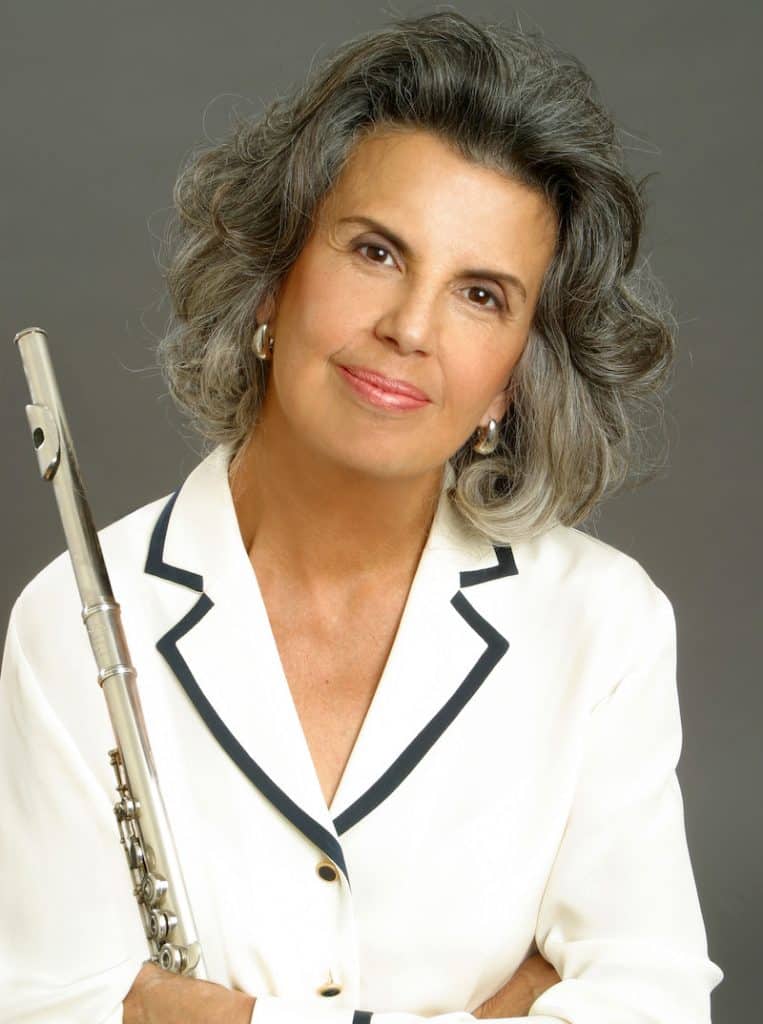
Jeanne Baxtresser (born 1947) is an American flutist and teacher.
She began her musical career at the young age of 10 where she learned the flute after trying (and failing) to learn the piano.
She soon progressed and began taking lessons with Emil Opava who was in the Minnesota Orchestra at the time.
She went on to study at Julliard in New York and in her final year won a position in the Montreal Symphony.
She played there for 7 years after which she joined the Toronto Symphony Orchestra before eventually being invited to join as the principal flutist of the New York Philharmonic in 1981 where she stayed for over fifteen years and held numerous professorships.
She made many recordings as both an orchestral musician and soloist and was awarded even a lifetime achievement award from the National Flute Association in 2006 for ‘upholding an increasingly higher standard of artistic excellence for the flute.’
3. Herbie Mann
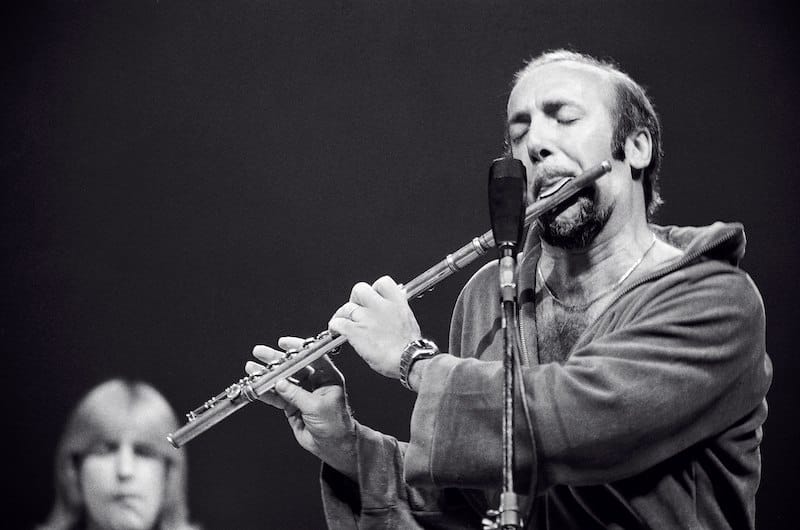
Herbie Mann became the first jazz flutist to base his career on only playing the flute (up until him most jazz flutists would play other instruments too).
Mann drew inspiration from a range of ethnic styles from Latin America and the Middle East, merging Jazz with World Music at a time when the latter term had barely been invented.
Mann had a memorable collaboration (and rivalry) with a fellow jazz flutist, Sam Most.
Despite their differences, the two men played together frequently and at their gigs you’d hear their ‘fans’ shouting slogans like ‘Most is the man!’ to which Mann’s supporters would counter ‘Mann is the most!’.
4. Jean Pierre Rampal
Born in 1922,Jean Pierre Rampal is widely credited with ‘returning to the flute the popularity as a solo classical instrument it had not held since the 18th Century.’
Rampal had a phenomenal technique and a bright sound and, with his Latin temperament, he thrilled audiences with his virtuosic displays.
He really popularized the flute as a solo instrument, recovering huge numbers of forgotten flute compositions from the baroque era and encouraging contemporary composers of the time to write music for the instrument including Francis Poulenc whose Sonata is now a key piece in every flutist’s repertoire.
Rampal really paved the way for the next generation of flute superstars like Emmanuel Pahud and James Galway.
5. Ian Anderson
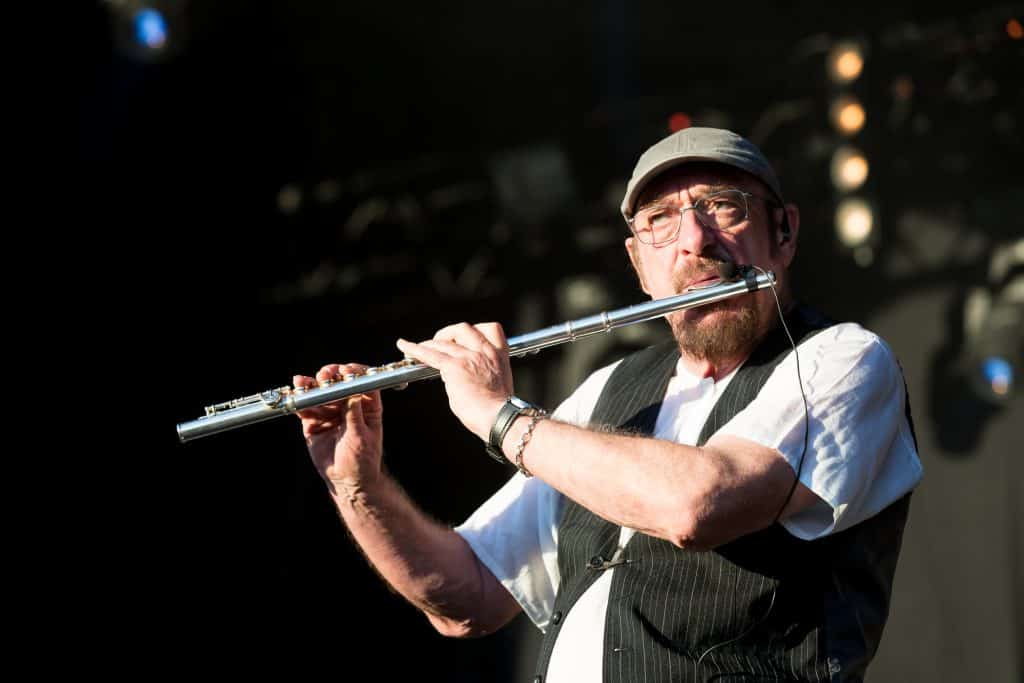
Moving away from classical and Jazz music, next we haveIan Anderson who is known for being the flutist for the rock band Jethro Tull.
Growing up in Scotland and then Blackpool in the northwest of England, Anderson began by playing guitar and singing in rock bands.
He eventually packed it in as he didn’t think he’d ever be as good as other guitar virtuosos such as Eric Clapton.
He even traded his guitar in for a flute and found he quickly became good and could easily play in a bluesy rock style.
He even ended up playing on the Jethro Tull album “This Was” after allegedly only playing for a few months!
6. Bobbi Humphrey
Bobbi Humphrey (born 1950) was the first-ever female artist to be signed by blue note she plays jazz, funk and soul-jazz and has recorded twelve albums both as a flutist and singer.
Despite this notable success, and collaborations with artists like Herbie Mann, Duke Ellington, and George Benson, Bobbi became frustrated by the lack of money earned through her performances and recordings.
She went on to set up her own record label and music management company in 1994 with the aim of providing a better deal for performers.
7. Theobald Boehm

Any discussion about famous flutists would not be complete without the mention of Theobald Boehm (1794 – 1881).
Although Boehm was an important figure in the history of the flute, he was not well known as a performer but, as an instrument-maker.
He created the complex key mechanism which first allowed the flute to be truly chromatic and to play in tune.
This system is still the basis of flute design today.
8. Yusef Lateef
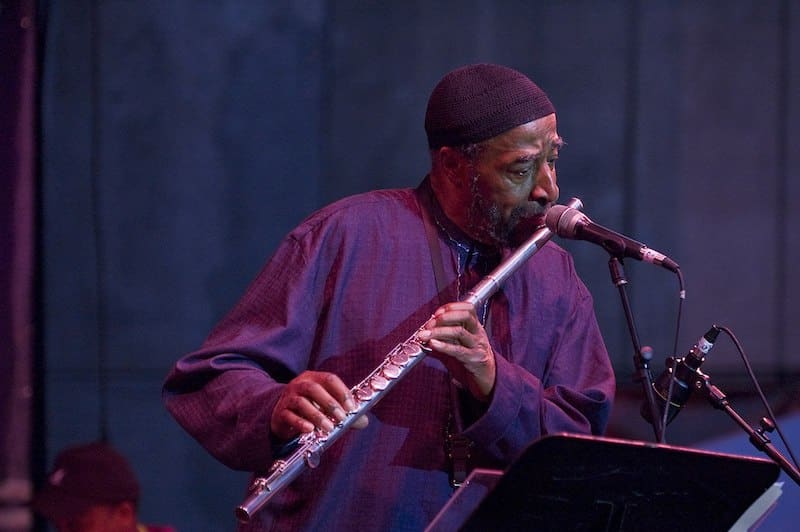
The world music influence was also a key element of the music of Yusef Lateef who became famous in the early 1960s as a member of the Cannonball Adderley Sextet, led by the saxophonist Julian Edwin “Cannonball” Adderley who played and recorded with famous trumpet player Miles Davis.
Lateef was known for developing Sam Most’s vocal techniques by speaking syllables into the instrument to achieve unusual effects.
Latif was also the first jazz flutist to use different types of ethnic flutes like the Chinese flute, the Arab ‘nai’ flute, and the ‘ma ma’ flute which he invented himself.
9. Emmanuel Pahud

Emmanuel Pahud (born in 1970 – Geneva, Switzerland) was not from a musical family but was captivated by the flute from an early age.
He enjoyed a classical training at the Paris Conservatoire and became a flutist with the Berlin Philharmonic Orchestra in 1992, progressing to principal, a position he now shares.
He is famous for his versatility, having made recordings and given performances in diverse musical genres including baroque, jazz, and contemporary.
10. Jasmine Choi
Jasmine Choi was born in Seoul, South Korea but was educated in the US and now lives in Austria.
She has won numerous prizes including during her time as a student at the Julliard School and held positions in a number of orchestras including principal flute at the Vienna Symphony.
Choi’s solo career soon took off though and she has made numerous recordings that have crossed musical genres and included her own compositions.
In 2016 she was named as a ‘cultural ambassador’ for her hometown of Daejon in Korea.
11. Marcel Moyse

Marcel Moyse was born in France in 1889 and studied at the Paris Conservatoire under Philippe Gaubert and Paul Taffanel.
He went on to play principal flute in various Paris orchestras and also made his name as a soloist, showcasing his strong, clear and flexible tone with a fast vibrato, very much in the French style.
For much of his life, however, Moyse lived and worked in Canada and the US where he became a prominent teacher, striving to teach his students “not how to play the flute, but to make music.”
Many famous flutists of the twentieth century were his students including James Galway, Trevor Wye, and William Bennett, all of whom later became prominent teachers themselves.
12. Jacques Hotteterre

Jacques Hotteterre (1674 – 1763) has since been credited with being the ‘inventor’ of the baroque flute.
He even wrote what is thought to be the first-ever published instruction manual on how to play the flute in 1719 entitled “L’Art de Preluder sur la Flute Transversaire” (translated as “The Art of Playing the Transverse Flute”).
13. Gareth Davies
One of the most well-respected orchestra flutists has to be Gareth Davies who studied at Guildhall School of Music and Drama before becoming the youngest ever principal flutist at Bournemouth Symphony Orchestra aged only 23.
More success swiftly followed, and Davies was appointed leader of the LSO in 2000, a position he still holds.
With the orchestra, he has made numerous recordings across the classical repertoire and of film music, including ‘Harry Potter’ and ‘Star Wars.’
In addition to his performing career, Davies is also in demand as a teacher regularly working with schools, conservatories, and universities to mentor up-and-coming performers.
14. Frank Wess
Frank Wess, a member of the Count Basie Big Band, was the first jazz flutist to record extensively with a big band and to perform on radio.
Famous recordings like ‘Perdido’ in 1954, did a huge amount to raise the profile of the instrument in the jazz world.
Many arrangements were written with flute solos especially for Wess and, after he left the band, it became apparent that a new tradition had begun and his role was taken over by tenor saxophonist/flutist Eric Dixon.
15. Johann Joachim Quantz
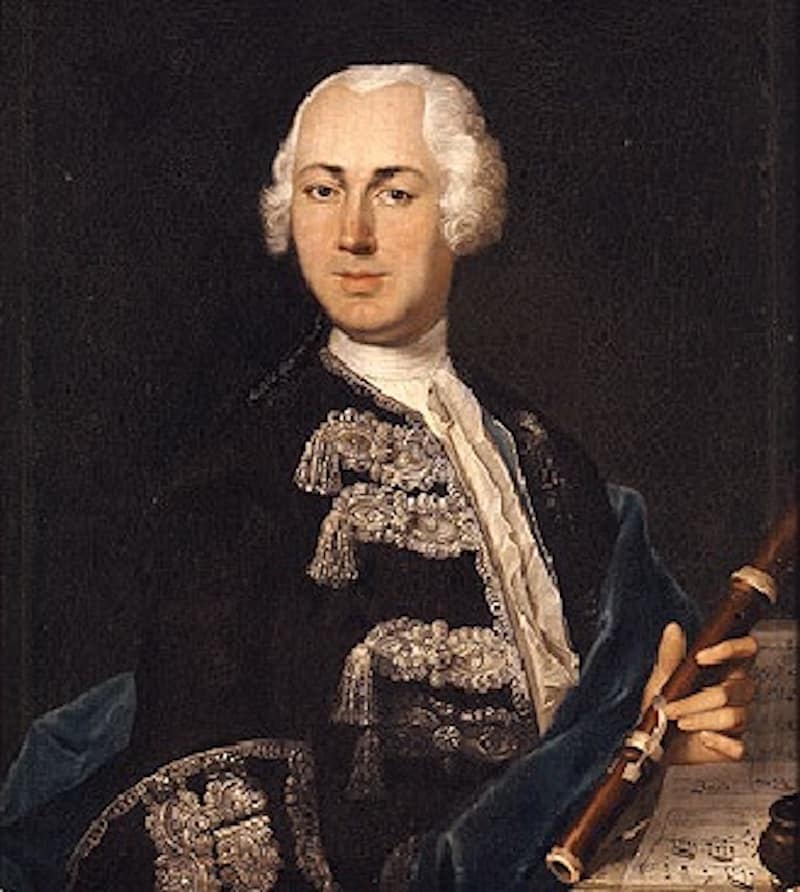
Hotteterre was shortly followed by the now more famous Johann Joachim Quantz (1697-1773) who also wrote a treatise on the flute in 1757 which influenced performers enormously throughout the 18th century.
Quantz also contributed to the evolution of the instrument’s design and considerably to its repertoire, writing almost 600 pieces in different genres, almost all of them including the flute.
He was also a court musician – an esteemed position in those days.
16. Matt Molloy
In the world of folk music, Ireland was becoming a ‘hotspot’ of talent and the flute was one of the most commonly played instruments.
One of these talented flutists was Matt Molloy, born in 1947 and winner of the All-Ireland Flute Championship at the age of only nineteen.
Molloy is still considered one of the most brilliant Irish musicians and his style that adapts piping techniques to the flute has influenced many contemporary Irish folk flutists.
Molloy found fame as a soloist but primarily in groups including The Bothy Band and Planxty before joining the Chieftains in 1979.
He now owns a pub in Ireland where he regularly hosts Irish Music sessions between his performing and recording commitments.
During the second half of the twentieth century, artists became ever more adventurous, breaking down boundaries between genres and creating new types of fusion music.
17. Robert Dick

A flutist of perhaps even greater scope (in terms of musical genres) is Robert Dick, also born in 1950.
Dick is a composer, teacher, and author, as well as a performer, and his style, is a mixture of classical, world music, electronic and jazz.
Throughout his career, Dick has recorded a huge range of music across multiple genres but most recently has focused on performing and improvising his own music.
Perhaps his most significant legacy is, however, his invention of the ‘glissando head joint’ – a customized flute head joint that allows the performer to slide between the chromatic pitches usually played on the flute, rather like on an electric guitar.
For this achievement amongst others, Dick was awarded the ‘Lifetime Achievement Award’ by the National Flute Association and achieved great critical acclaim from the press including the New York Times who said his ‘technical resources and imagination seem limitless’ and the Jazz Times who called him ‘revolutionary.’
18. Buddy Collette
Buddy Collette, a notable jazz performer who had played the drummer Chico Hamilton, was the first jazz flutist to record on all of the members of the orchestral flute family.
Collette formed a group with three other flutists called the ‘Swinging Shepherds’ who made some amazing recordings really exploiting the combination of the differently pitched flutes.
He also explored hitherto un-heard of instrumental combinations, blending his light and airy sound with a muted trumpet to great effect – an idea that was copied by many subsequent jazz arrangers, composers, and musicians.
19. Roland Kirk
Roland Kirk was a multi-instrumentalist who became famous for his ability to play three saxophones at once!
Kirk both sang and spoke through the flute to create some incredible effects and was also the first flutist to record widely on unusual flutes including the bamboo flute, the nose flute, and a range of whistles.
Other ‘firsts’ include his use of key clicks and other percussive sounds – Kirk was a true innovator in his time.
Jazz was not the only genre where flutists were making their presence felt.
20. Alberto Socarras Estacio
(19.9.08 – 26.8.87) was born in Cuba and later moved to the US.
He discovered Jazz at an early age and, undeterred by the limitations of the instrument’s volume, performed, and recorded, what is widely thought to be the first-ever jazz flute solo on a track called ‘Shooting the Pistol’ with the Clarence Williams Orchestra.
The problems with balance are addressed by clever arranging and by Alberto’s use of the high octave which could be heard over the lower brass and wind instruments.
21. Wayman Carver
Perhaps better known is Wayman Carver (25.12.05 – 6.5.67) who is frequently described as ‘the first jazz flutist.’
Carver was one of a very small number of flutists active in the swing era and he performed with some of the great ‘jazzers’ of the time including Dave Nelson, Benny Carter, Spike Hughes, and even Ella Fitzgerald.
He recorded with the Chick Webb band for several years, soloing on tracks like “Sweet Sue” and “I Got Rhythm.”
In 1944 Time Magazine described Carver as ‘a brilliant hot flutist who had played with some of the best jazz bands’ – fame indeed!
Carver went on to have an equally esteemed career as a teacher and lecturer, passing his skills on to the next generation of performers.
22. Severino Gazzelloni (1919-1992)
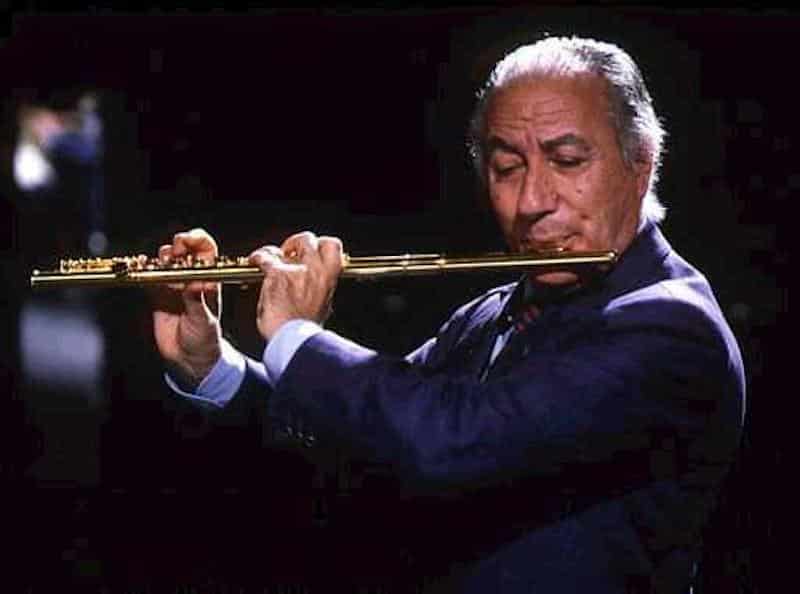
A key figure in this period of experimentation was the Italian flutist Severino Gazzeloni to whom Berio dedicated his Sequenza.
Severino Gazzeloni (1919 – 1992) was an Italian flutist who many people consider to be one of the best flutists of all time.
He performed as a member of the Symphony Orchestra of the RIA in Rome for over thirty years and also enjoyed a highly successful career as both a solo performer and teacher.
Gazzeloni’s music really transcended genres and traditions.
Not only was he a world-renowned exponent of avant-garde music, as with Berio’s ‘Sequenza’ and other works written for him by composers like Boulez and Stravinsky, he was also well thought of as a jazz musician and a ‘fusion’ artist, wowing audiences with his performances across the world.
23. Ron Burgundy
And lastly, we thought we include one of the best jazz flutists of cinema, Ron Burgundy.
Known for his outrageous style where he would walk on top of tables, smashing patrons’ glasses as well as even drinking them!
He is definitely one of the most famous flutists (and also one of our favorite).
Summing up the Greatest Flutists of all Time
In this article, we have traced the evolution of the flute through the eyes of those who play it – the flutists.
The flutists described here certainly do not form an exhaustive list and exciting new flutists are emerging all the time, throughout the world and across musical genres.
The possibilities for the flute are truly endless and I, for one, can’t wait to see what the next generation of flutists will create.


